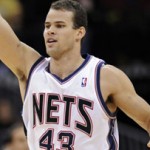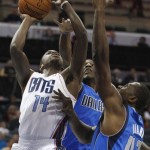Training camps open in just over a month from now, on Sept. 28, so it’s time to start taking a critical look at the 2013-2014 NBA season.
Plenty of players around the league are facing uncertain futures, with contract statuses to be resolved and career trajectories at stake.
With that in mind, this post is the first of a two-part series of players around the league heading into make-or-break seasons of varying degrees.
Jared Sullinger, F, Boston Celtics
 There’s no questioning his on-court ability, and he has proven that he can be at least a quality rotation player when healthy. But that injury red flag is larger than those you would find in Beijing or Moscow.
There’s no questioning his on-court ability, and he has proven that he can be at least a quality rotation player when healthy. But that injury red flag is larger than those you would find in Beijing or Moscow.
He was limited to 45 games in his rookie season before he had to miss the rest of the season with major back surgery. When he played, his effort and ability on the defensive end (he had a sterling 102 defensive rating) provided a big boost to the Celtics and quickly endeared him to the hard-to-please Boston fan base.
Sullinger only played 19.8 minutes per contest, but his per-36 minute numbers are really good. He shot 49.3 percent from the field, a number that can be improved upon, but he averaged 10.9 points and 10.7 rebounds per 36. He also got better as the season went on:
| Sullinger | Minutes | FG % | Points | Rebounds |
| November | 19.2 | 52.1 | 5.9 | 4.8 |
| December | 17.7 | 45.8 | 5.3 | 5.9 |
| January | 23.2 | 49.5 | 7 | 7.2 |
Can Sullinger remain on the court and carry this success over to this coming season? Boston holds a team option on his deal for the next season, and with the team rebuilding, they will have watch to see whether Sullinger can put together a healthy season.
Kris Humphries, F, Boston Celtics
 Humphries seems destined for the rebuilding team’s version of St. Helena. A veteran player on the final year of an overpaid contract on a Boston team that would probably prefer to play its younger players to prepare its core for the future.
Humphries seems destined for the rebuilding team’s version of St. Helena. A veteran player on the final year of an overpaid contract on a Boston team that would probably prefer to play its younger players to prepare its core for the future.
After playing 35 minutes per game for the Nets in 2011-2012, his playing time was cut nearly in half last season to 18.3. His per-36 minute numbers were down practically across the board and you have to wonder where Humphries will play after this season and how much his annual salary will be sliced from its currently bloated $12 million number.
(RELATED: BOSTON CELTICS: FIVE THINGS TO WATCH FOR)
This may seem crazy right now, but Humphries’ best-case scenario could be Drew Gooden’s career.
| Age 27 | PER | O Rating | D Rating | WS | WS/48 |
| Humphries | 13.6 | 109 | 105 | 2.7 | 0.109 |
| Gooden | 16.3 | 106 | 106 | 2.7 | 0.102 |
Gooden averaged 17.2 points per game for three teams in that season, while Humphries averaged 5.8 last year. Gooden got a huge contract from Milwaukee that was recently amnestied, but it’s difficult to imagine Humphries approaching those numbers going forward. All he can do is play well when new head coach Brad Stevens inserts him into the game and hope another team will be foolish enough to give him Gooden money next summer.
Michael Kidd-Gilchrist, Charlotte Bobcats
 What type of player is Michael Kidd-Gilchrist? A foundational piece? A strong rotation player? A one-dimensional defensive player?
What type of player is Michael Kidd-Gilchrist? A foundational piece? A strong rotation player? A one-dimensional defensive player?
MKG finished with a nine point-per-game average on a very respectable 45.8 percent shooting, but his scoring average fell from 11 per game in November and December down to just 8.4 in April. His rebounding stats improved to 7.6 per game in April, but he shot just 22.2 percent from three and his win share and offensive and defensive ratings weren’t very good.
He averaged 26 minutes per game last season, and his per-36 minute numbers of 12.5 points and 8.1 rebounds are really good. But with Al Jefferson and rookie Cody Zeller presumably taking more offensive touches away from Kidd-Gilchrist, and the returning backcourt of Kemba Walker and Gerald Henderson taking its fair share of shots, where does MKG fit in offensively?
Kidd-Gilchrist has team options of $5.01 million next summer and $6.33 million the next season. Will he prove he’s worth that number going forward? He’ll get the chance to prove he’s more than just an over-drafted bit player for the Bobcats.
Bismack Biyombo, Charlotte Bobcats
Biyombo’s improvement in his second season was negligible at best. The 20-year-old Congo native is still so very raw on the offensive end, and his overall efficiency numbers didn’t increase along with his slight uptick in minutes played from 23.1 to 27.3.
| Biyombo | FG % | Points | Rebounds | Blocks | PER | O Rtg | D Rtg | WS | WS/48 |
| 2011-2012 | 46.4 | 5.2 | 5.8 | 1.8 | 10.6 | 92 | 107 | 0.6 | 0.019 |
| 2012-2013 | 45.1 | 4.8 | 7.3 | 1.8 | 10.1 | 98 | 109 | 1.4 | 0.031 |
Charlotte will probably pick up Biyombo’s option of $4.09 million next summer, but will he really show enough improvement to justify that salary. With Jefferson and Zeller now in the fold, it would appear that Biyombo will be further marginalized on this team.
Can Biyombo prove any significant worth on the offensive end to justify him playing more than 27 minutes a game with an improved Bobcats frontcourt anchored by Al Jefferson? Right now it seems like Biyombo’s long-term future isn’t in Charlotte.